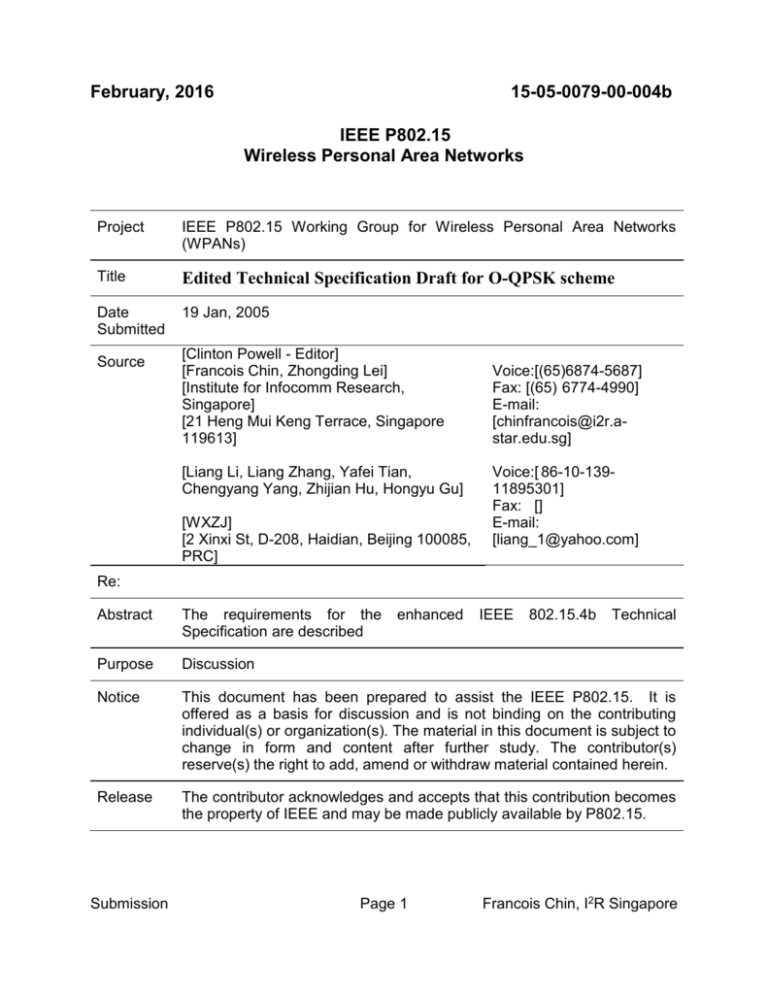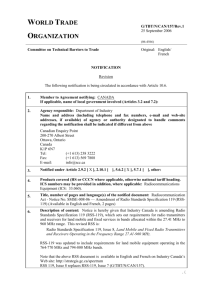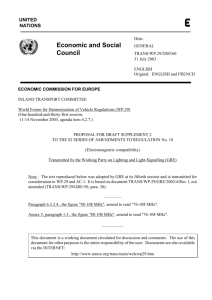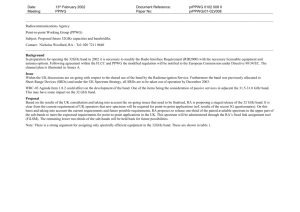15-05-0079-00-004b-edited-technical-specification-draft
advertisement

February, 2016 15-05-0079-00-004b IEEE P802.15 Wireless Personal Area Networks Project IEEE P802.15 Working Group for Wireless Personal Area Networks (WPANs) Title Edited Technical Specification Draft for O-QPSK scheme Date Submitted 19 Jan, 2005 Source [Clinton Powell - Editor] [Francois Chin, Zhongding Lei] [Institute for Infocomm Research, Singapore] [21 Heng Mui Keng Terrace, Singapore 119613] [Liang Li, Liang Zhang, Yafei Tian, Chengyang Yang, Zhijian Hu, Hongyu Gu] [WXZJ] [2 Xinxi St, D-208, Haidian, Beijing 100085, PRC] Voice:[(65)6874-5687] Fax: [(65) 6774-4990] E-mail: [chinfrancois@i2r.astar.edu.sg] Voice:[ 86-10-13911895301] Fax: [] E-mail: [liang_1@yahoo.com] Re: Abstract The requirements for the Specification are described Purpose Discussion Notice This document has been prepared to assist the IEEE P802.15. It is offered as a basis for discussion and is not binding on the contributing individual(s) or organization(s). The material in this document is subject to change in form and content after further study. The contributor(s) reserve(s) the right to add, amend or withdraw material contained herein. Release The contributor acknowledges and accepts that this contribution becomes the property of IEEE and may be made publicly available by P802.15. Submission enhanced Page 1 IEEE 802.15.4b Technical Francois Chin, I2R Singapore February, 2016 15-05-0079-00-004b IEEE 802.15.4b Draft Section 6.8 6.8 Enhanced 868 / 915 MHz PHY specifications The requirements for the enhanced 868/915 MHz PHY are specified in 6.8.1 through 6.8.3. 6.8.1 Data rate The data rate of the enhanced 868/915 MHz PHY shall be 100 Kb/s when operating in the 868 MHz band and 250 kb/s when operating in the 915 MHz band. 6.8.2 Modulation and spreading The enhanced 868/915 MHz PHY employs a 16-ary quasi-orthogonal modulation technique. During each data symbol period, four information bits are used to select one of 16 nearly orthogonal pseudo-random noise (PN) sequences to be transmitted. The PN sequences for successive data symbols are concatenated, and the aggregate chip sequence is modulated onto the carrier using offset quadrature phase-shift keying (OQPSK). 6.8.2.1 Reference modulator diagram The functional block diagram in Figure 18 is provided as a reference for specifying the enhanced 868/915 MHz PHY modulation and spreading functions. The number in each block refers to the subclause that describes that function. Binary Data from PPDU Bit-toSymbol (6.8.2.2) Symbol-toChip (6.8.2.3) O-QPSK Modulator (6.8.2.4) Modulated Signal Figure 18 – Modulation and Spreading Functions 6.8.2.2 Bit-to-symbol mapping Submission Page 2 Francois Chin, I2R Singapore February, 2016 15-05-0079-00-004b All binary data contained in the PPDU shall be encoded using the modulation and spreading functions shown in Figure 18. This subclause describes how binary information is mapped into data symbols. The 4 LSBs (b0, b1, b2, b3) of each octet shall map into one data symbol, and the 4 MSBs (b4, b5, b6, b7) of each octet shall map into the next data symbol. Each octet of the PPDU is processed through the modulation and spreading functions (see Figure 18) sequentially, beginning with the preamble field and ending with the last octet of the PSDU. Within each octet, the least significant symbol (b0, b1, b2, b3) is processed first and the most significant symbol (b4, b5, b6, b7) is processed second. 6.8.2.3 Symbol-to-chip mapping Each data symbol shall be mapped into a 16-chip PN sequence as specified in Table 20. Table 20 – Symbol-to-chip mapping Data symbol (decimal) Data symbol (binary) (b0, b1, b2, b3) Chip values (c0 c1 … c14 c15) 0 1 2 3 4 5 6 7 8 9 10 11 12 13 14 15 0000 1000 0100 1100 0010 1010 0110 1110 0001 1001 0101 1101 0011 1011 0111 1111 0011111000100101 0100111110001001 0101001111100010 1001010011111000 0010010100111110 1000100101001111 1110001001010011 1111100010010100 0110101101110000 0001101011011100 0000011010110111 1100000110101101 0111000001101011 1101110000011010 1011011100000110 1010110111000001 6.8.2.4 O-QPSK modulation The chip sequences representing each data symbol are modulated onto the carrier using O-QPSK with half sine pulse shaping. Even-indexed chips are modulated onto the inphase (I) carrier and odd-indexed chips are modulated onto the quadrature-phase (Q) carrier. Because each data symbol is represented by a 16-chip, the chip rate is 16 times Submission Page 3 Francois Chin, I2R Singapore February, 2016 15-05-0079-00-004b the symbol rate. To form the offset between I-phase and Q-phase chip modulation, the Qphase chips shall be delayed by Tc with respect to the I-phase chips (see Figure 19), where Tc is the inverse of the chip rate. 2Tc c0 I-Phase c2 c1 Q-Phase … c4 c3 c14 … c5 c15 Tc Figure 19 – O-QPSK chip offsets 6.8.2.5 Pulse shape The half-sine pulse shape used to represent each baseband chip is described by t ) 0 t 2Tc sin( p(t ) 2Tc 0 otherwise (1) Figure 20 shows a sample baseband chip sequence (the zero sequence) with half-sine pulse shaping. TC I-phase 0 Q-phase 1 0 1 1 0 1 1 0 1 0 0 0 0 1 1 2TC Figure 20 – Sample baseband chip sequences with pulse shaping 6.8.2.6 Chip transmission order Submission Page 4 Francois Chin, I2R Singapore February, 2016 15-05-0079-00-004b During each symbol period the least significant chip, c 0, is transmitted first and the most significant chip, c15, is transmitted last. 6.8.3 868/915 MHz band radio specification In addition to meeting regional regulatory requirements, devices operating in the 868/915 MHz band shall also meet the radio requirements in 6.8.3.1 through 6.8.3.5. 6.6.3.1 Operating frequency range The enhanced 868/915 MHz PHY operates in the 868.0-868.6 MHz frequency band and in the 902–928 MHz frequency band. 6.8.3.2 Transmit power spectral density (PSD) mask When operating in the 868 MHz band, the signal shall be filtered before transmission to regulate the transmit PSD. A raised cosine filter with roll-off factor r = 0.6 shall be used, which can be specified by f (t ) sin( t / Tc ) cos( rt / Tc ) t / Tc 1 4r 2 t 2 / Tc2 (2) When operating in the 915 MHz band, the transmitted spectral products shall be less than the limits specified in Table 22. For both relative and absolute limits, average spectral power shall be measured using a 100 kHz resolution bandwidth. For the relative limit, the reference level shall be the highest average spectral power measured within ± 1 MHz of the carrier frequency fc. Table 22– Transmit PSD in the 915 MHz band Frequency Relative limit Absolute limit | f – fc | 1.2 MHz -20 dB -20 dBm 6.8.3.3 Symbol rate The symbol rate of the enhanced 868/915 MHz PHY shall be 25 ksymbol/s ± 40 ppm when operating in the 868 MHz band; and 62.5 ksymbol/s ± 40 ppm when operating in the 915 MHz band. 6.8.3.4 Receiver sensitivity Submission Page 5 Francois Chin, I2R Singapore February, 2016 15-05-0079-00-004b Under the conditions specified in 6.1.6, a compliant device shall be capable of achieving a sensitivity of –90 dBm or better. 6.8.3.5 Receiver jamming resistance This subclause applies only to the 902-928 MHz band as there is only one channel available in the 868.0-868.6 MHz band. The minimum jamming resistance levels are given in Table 23. The adjacent channel is one on either side of the desired channel that is closest in frequency to the desired channel, and the alternate channel is one more removed from the adjacent channel. For example, when channel 5 is the desired channel, channel 4 and channel 6 are the adjacent channels and channel 3 and channel 7 are the alternate channels. Table 23—Minimum receiver jamming resistance requirements for enhanced 915 MHz PHY Adjacent channel rejection Alternate channel rejection 0 dB 30 dB The adjacent channel rejection shall be measured as follows: The desired signal shall be a compliant 915 MHz IEEE 802.15.4b signal of pseudo-random data. The desired signal is input to the receiver at a level 3 dB above the maximum allowed receiver sensitivity given in 6.8.3.4. In either the adjacent or the alternate channel, an IEEE 802.15.4 signal is input at the relative level specified in Table 25. The test shall be performed for only one interfering signal at a time. The receiver shall meet the error rate criteria defined in 6.1.6 under these conditions. Submission Page 6 Francois Chin, I2R Singapore





